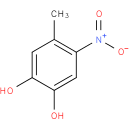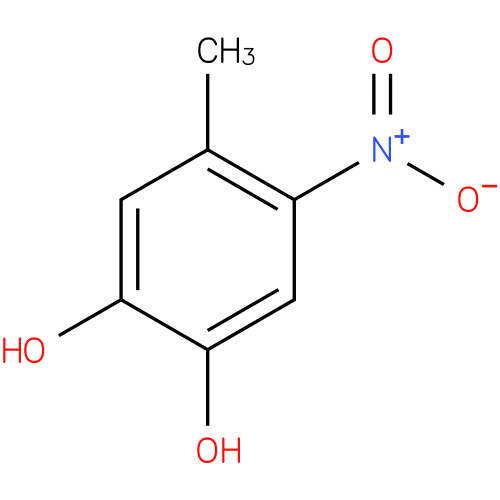|
Record Information |
|---|
| Version |
1.0 |
|---|
| Update Date |
1/22/2018 11:54:54 AM |
|---|
|
Metabolite ID | PAMDB100011 |
|---|
|
Identification |
|---|
| Name: |
4-methyl-5-nitrocatechol |
|---|
| Description: | A nitrotoluene that is 2-nitrotoluene carrying two hydroxy substituents at positions 4 and 5. |
|---|
|
Structure |
|
|---|
| Synonyms: | - 4-methyl-5-nitrocatechol
- 4M5NC
|
|---|
|
Chemical Formula: |
C7H7NO4 |
|---|
| Average Molecular Weight: |
169.1348 |
|---|
| Monoisotopic Molecular
Weight: |
169.038 |
|---|
| InChI Key: |
WLLRAKCRHPMKNA-UHFFFAOYSA-N |
|---|
| InChI: | InChI=1S/C7H7NO4/c1-4-2-6(9)7(10)3-5(4)8(11)12/h2-3,9-10H,1H3 |
|---|
| CAS
number: |
Not Available |
|---|
| IUPAC Name: | 4-methyl-5-nitrobenzene-1,2-diol |
|---|
|
Traditional IUPAC Name: |
Not Available |
|---|
| SMILES: | Cc1cc(O)c(O)cc1[N+]([O-])=O |
|---|
|
Chemical Taxonomy |
|---|
|
Taxonomy Description | This compound belongs to the class of organic compounds known as nitrophenols. These are compounds containing a nitrophenol moiety, which consists of a benzene ring bearing both a hydroxyl group and a nitro group on two different ring carbon atoms. |
|---|
|
Kingdom |
Organic compounds |
|---|
| Super Class | Benzenoids |
|---|
|
Class |
Phenols |
|---|
| Sub Class | Nitrophenols |
|---|
|
Direct Parent |
Nitrophenols |
|---|
| Alternative Parents |
|
|---|
| Substituents |
- Nitrophenol
- Nitrobenzene
- Nitrotoluene
- Nitroaromatic compound
- Catechol
- M-cresol
- P-cresol
- 1-hydroxy-2-unsubstituted benzenoid
- Toluene
- Monocyclic benzene moiety
- C-nitro compound
- Organic nitro compound
- Organic 1,3-dipolar compound
- Organic oxoazanium
- Propargyl-type 1,3-dipolar organic compound
- Allyl-type 1,3-dipolar organic compound
- Organic nitrogen compound
- Hydrocarbon derivative
- Organic oxide
- Organonitrogen compound
- Organooxygen compound
- Organic oxygen compound
- Organopnictogen compound
- Aromatic homomonocyclic compound
|
|---|
| Molecular Framework |
Aromatic homomonocyclic compounds |
|---|
| External Descriptors |
- catechols, nitrotoluene (CHEBI:81666)
- a catechol, a nitroaromatic compound (CPD-9134)
|
|---|
|
Physical Properties |
|---|
| State: |
Not Available |
|---|
| Charge: | 0 |
|---|
|
Melting point: |
Not Available |
|---|
| Experimental Properties: |
Not Available |
|---|
| Predicted Properties |
|
|---|
|
Biological Properties |
|---|
| Cellular Locations: |
Not Available |
|---|
| Reactions: | |
|---|
|
Pathways: |
|
|---|
|
Spectra |
|---|
| Spectra: |
Not Available |
|---|
|
References |
|---|
| References: |
- Rodríguez MC, Monti MR, Argaraña CE, Rivas GA. Enzymatic biosensor for the
electrochemical detection of 2,4-dinitrotoluene biodegradation derivatives.
Talanta. 2006 Feb 28;68(5):1671-6. doi: 10.1016/j.talanta.2005.08.032. Pubmed: 18970513
|
|---|
| Synthesis Reference: |
Not Available |
|---|
| Material Safety Data Sheet (MSDS) |
Not Available |
|---|
|
Links |
|---|
| External Links: |
| Resource | Link |
|---|
| KEGG COMPOUND | C18315 |
|
|---|


